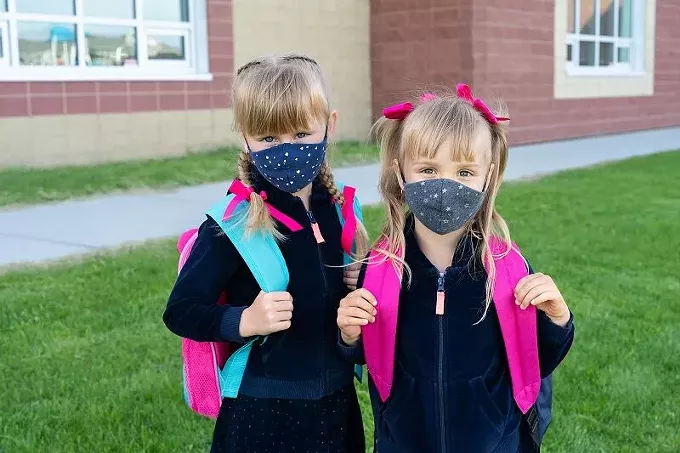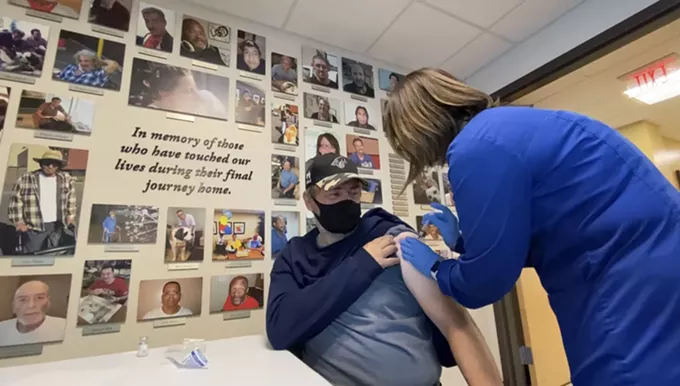Wednesday, August 11, 2021
A sixth-grade class in the Amphitheater Unified School District will shift to remote learning until Aug. 19 after reported cases of COVID-19 in the class, Principal Jason Weaver announced in a letter to families on Tuesday.
Amphi students returned to school on Aug. 5 during a wave of COVID-19 cases. Most school districts in Pima County, including Amphi, decided not to require masks, which would be a violation of state law. District officials are only encouraging mask-wearing.
In the letter, Weaver said the district provided contact tracing information to the Pima County Health Department for anyone in the Harelson Elementary School class. Close contacts are defined as anyone who was within six feet of an infected person or within three feet if one of the contacts was wearing a mask for a total of 15 minutes or more over a 24-hour period.
As of Wednesday, the school district reported nearly 30 cases district-wide - six cases among teachers and 21 students - with three active cases at Harelson Elementary. Since July 20, the health department has received reports of 386 COVID-19 cases and 19 outbreaks across Pima County school districts.
The sixth-grade class will receive remote instruction from a certified teacher who has worked at the school for many years and has taught for Amphi Academy Online, according to Michelle Valenzuela, director of Communications.
“During this time and as we move forward during this year, I encourage all of us to provide support and strength to one another,” said Weaver. “I am grateful to my staff and the wider Harelson community for their patience, understanding and dedication to our students.”
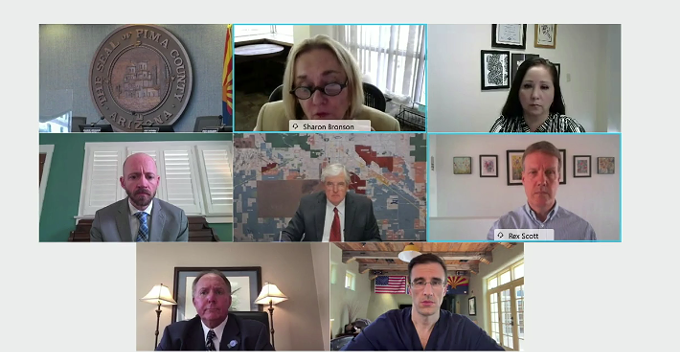
Supervisors Matt Heinz and Adelita Grijalva supporting the emergency proclamation The Pima County Board of Supervisors voted against several COVID-19 related motions at its Tuesday meeting.
With the number of COVID-19 on the rise because of the Delta variant, the board considered several resolutions including, reinstating an emergency proclamation for COVID-19, mandating vaccinations for county employees, instituting mask mandates for K-12 county schools and mandating vaccinations for all healthcare workers in Pima County.
The board voted 3-2 against proclaiming the COVID-19 pandemic an emergency situation. Supervisors Matt Heinz and Adelita Grijalva supporting the emergency proclamation.
Supervisors Matt Heinz and Adelita Grijalva, who supported the emergency proclamation, argued that the declaration would signal to county residents the seriousness of the current state of the pandemic.
During the past month, Pima County’s level of transmission changed from moderate to high, with a rate of 120 cases per 100,000 individuals in the last seven days, according to the CDC.
“People will understand that we have a state of emergency and will take this more seriously and hopefully move to get vaccinated,” Heinz said. “The county will have more ability to more quickly respond to the changing conditions on the ground on behalf of the health department to make the residents safer and to protect lives.”
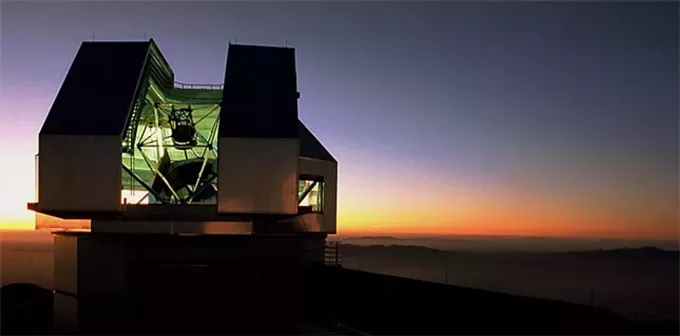
One of the most precise instruments for detecting planets is being used at the Kitt Peak National Observatory on the Tohono O’odham Nation west of Tucson.
The NEID spectrometer looks for Earth-like planets outside our solar system by measuring slight changes in the light coming from distant stars. Those shifts are caused by the gravitational tug of nearby objects, such as planets, and the movement can be measured to determine how massive the object is.
NEID, which rhymes with “fluid,” is derived from the Tohono O’odham phrase “to see.” The instrument was built by Penn State University in partnership with NASA and the National Science Foundation and installed on Kitt Peak, where it became operational this summer. A University of Arizona team provides the spectrometer’s software hub.
Chad Bender, an instrument scientist for NEID and an associate astronomer at the University of Arizona’s Steward Observatory, said the technique has been used successfully since the 1990s, but NEID is superior to anything that’s come before.
“We’re pushing the boundary of sensitivity,” Bender said. “We’re much more sensitive than the previous generation of instruments that have used this technique to search for planets.”
That precision helps find planets that are closer to the mass of Earth.
Monday, August 9, 2021

Summer 2021 will likely be one of the hottest on record as dozens of cities in the West experience all-time high temperatures. The extreme heat being felt throughout many parts of the U.S. is causing hundreds of deaths, sparking wildfires and worsening drought conditions in over a dozen states.
How does all this broiling heat affect the broader economy?
As an economist who has studied the effects of weather and climate change, I have examined a large body of work that links heat to economic outcomes. Here are four ways extreme heat hurts the economy – and a little good news.
1. Growth takes a hit
Research has found that extreme heat can directly hurt economic growth.
For example, a 2018 study found that the economies of U.S. states tend to grow at a slower pace during relatively hot summers. The data shows that annual growth falls 0.15 to 0.25 percentage points for every 1 degree Fahrenheit that a state’s average summer temperature was above normal.
Laborers in weather-exposed industries such as construction work fewer hours when it’s hotter. But higher summer temperatures reduce growth in many industries that tend to involve indoor work, including retail, services and finance. Workers are less productive when it’s hotter out.
2. Crop yields drop
Agriculture is obviously exposed to weather: After all, crops grow outdoors.
Wednesday, August 4, 2021
The Tucson Unified School District board voted 4-0 at an emergency meeting Wednesday morning to require everyone to wear a mask on TUSD property.
Before school begins Thursday, the board decided to mandate masks on all TUSD campuses, motivated by the outbreaks in the Vail School District and with the growing number of pediatric cases.
Vail School District began school on July 19 and officials have reported 25 COVID-19 cases from students and staff as of July 25. On Monday, the district reported 57 student cases and 12 staff cases as of Aug. 1. TUSD is almost four times the size of Vail.
Last week, Dr. Theresa Cullen, director of Pima County's Health Department, said the county received reports of 56 cases since July 19 and eight outbreaks at schools.
For weeks, health experts warned of the expected outbreaks and high transmission in schools, especially with the inability of school districts to implement masking, because state law passed in June prohibits districts from mandating masks.
Dr. Joe Gerald, an epidemiologist with the UA Zuckerman School of Public Health, who has been tracking the virus since March of 2020, alerted the public to the impending outbreaks in his weekly forecast.
”Unlike the summer of 2020 when we were headed into school re-opening with generally declining rates, the match has been lit and the kindling is aflame this time,” wrote Gerald in an email. “For good measure, we are going to throw on some wet wood (children) in the coming weeks to ensure a robust bonfire for the Labor Day Marshmallow Roast. In the absence of greater vaccination or mask mandates, it is difficult to be optimistic about what might happen when schools are running at full capacity.”
The warning came along with the exponential rise in COVID-19 cases and the prevalence of the Delta variant, which is highly transmissible. Arizona has a high rate of transmission at 175 cases per 100,000 individuals for the seven day rolling average, while Pima County has about half that rate.
Friday, July 30, 2021
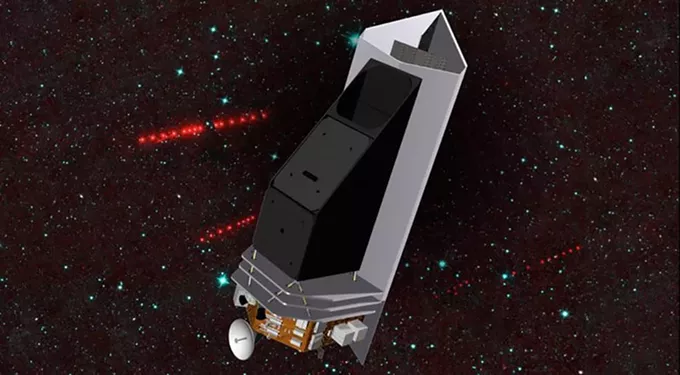
PHOENIX – NASA has appointed a University of Arizona professor to lead a project to track asteroids that potentially could crash into Earth. The mission involves launching a telescope into a high orbit to locate such near-Earth objects using the infrared radiation they emit.
Amy Mainzer, a professor of planetary sciences, will lead a team building the Near Earth Object Surveyor, an infrared telescope that will track and characterize any asteroids that one day could crash into the planet.
“We want to spot them when they are years to, ideally, decades away from any potential impact with the Earth,” Mainzer said.
Objects intersecting with the Earth’s orbit around the sun are classified as near-Earth objects, or NEOs. They can be as small as a car and big enough to obliterate an area the size of Southern California.
The telescope’s infrared sensors will detect the infrared light emitted by meteors, comets and other asteroids as they move in space.
The mission will help with two active projects run by UA to scan for NEOs. The Spacewatch Project and the Catalina Sky Survey are part of the ground-based surveys at the university’s Lunar and Planetary Laboratory, which track about 50% of all known near-Earth objects today.
“Each night, astronomers across the globe diligently use ground-based optical telescopes to discover new NEOs, characterize their shape and size, and confirm they do not pose a threat to us,” Kelly Fast, program manager for NASA’s NEO Observations Program, said in a news release. “Those telescopes are only able to look for NEOs in the night sky. NEO Surveyor would allow observations to continue day and night, specifically targeting regions where NEOs that could pose a hazard might be found.”
Thursday, July 29, 2021
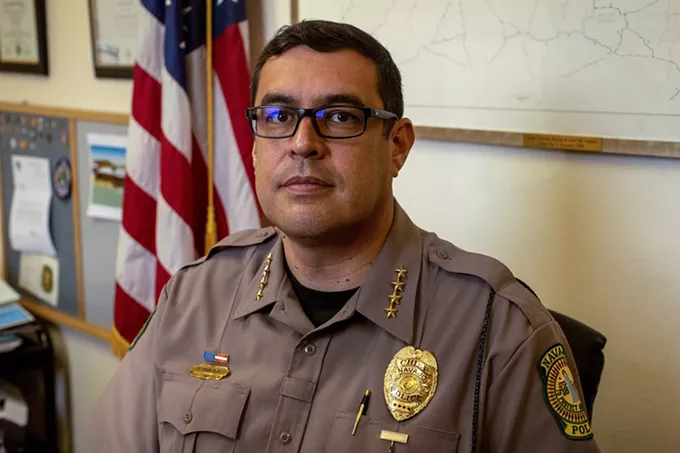
WINDOW ROCK – Navajo Chief of Police Phillip Francisco sits ramrod straight at his desk, surrounded by manila folders brimming with paperwork and a Darth Vader figurine that wields a pen as a lightsaber.
The chief, an Army veteran hired in 2016 after serving in several law enforcement departments in New Mexico, took charge after nearly eight years of rotating acting chiefs. He came from Farmington, New Mexico, to serve and protect the largest Native American tribe in the U.S. Francisco, 45, whose father is Navajo, grew up near the reservation.
A year before Francisco was sworn in, Officer Alex Yazzie was shot and killed while answering a domestic violence call. Francisco – who had been working closely with the Navajo Police Department while serving at nearby agencies – felt called to step in.
“Seeing the struggles that the Navajo Nation Police Department went through, I thought, ‘Maybe they need a leader.' "
The increased demands of the COVID-19 pandemic exacerbated issues in the department, Francisco said: chronic understaffing, dispatch systems that trail technology by 50 years and archaic facilities that include 71-year-old administrative buildings and a converted post office.
The 200-member department polices a rural area larger than West Virginia, he said, with dirt roads and houses so remote they don’t have addresses and can be out of range of police radios. During the pandemic, officers often worked 16- to 24-hour shifts to fill in for sick or quarantined colleagues.
Friday, July 23, 2021
PHOENIX – Although the percentage of those unwilling to take a COVID-19 vaccine has remained unchanged since May, Arizonans are showing less concern about the risks, according to a new survey by OH Predictive Insights.
The online opt-in panel survey of 1,000 adults, conducted from July 6-11, found that 42% of Arizonans were “slightly or not at all concerned” about the deadly disease, whereas 35% of Arizonans were “extremely or moderately concerned.”
“The data showed no statistically meaningful change from May in the number of Arizonans unwilling to take the COVID-19 vaccine (21%), while those who reported already taking the vaccine rose by 8%,” according to the survey. The margin of error is plus or minus 3.1 percentage points.
The decrease in “pandemic panic” comes at a time when the Arizona Department of Health Services’ daily curve showed an uptick in COVID-19 cases in the past week. Earlier this month, the daily number of new cases exceeded 1,000 for the first time since February. Arizona has recorded more than 18,100 deaths since January 2020.
Health experts say immunization is the best way to fight the Delta variant of the coronavirus that causes COVID-19, which quickly became the dominant strain in Arizona.
“By and large, it is a surge among the unvaccinated,” said Dr. Joshua LaBaer, executive director of the Biodesign Institute at Arizona State University, in a media briefing Wednesday. “The important take-home message is that the vaccines do work against this Delta variant.”
According to the survey, vaccine willingness rates varied among Arizonans of different racial groups, education levels and ages.
“College-educated white respondents reported an 81% vaccination rate while 57% of non-college-educated white respondents said they had been vaccinated,” the survey said. “However, 58% of college-educated Hispanic/Latinos say they have vaccinated, and a statistically equivalent 56% of non-college-educated Hispanic/Latinos are vaccinated as well.”
Thursday, July 22, 2021
Wednesday, July 14, 2021
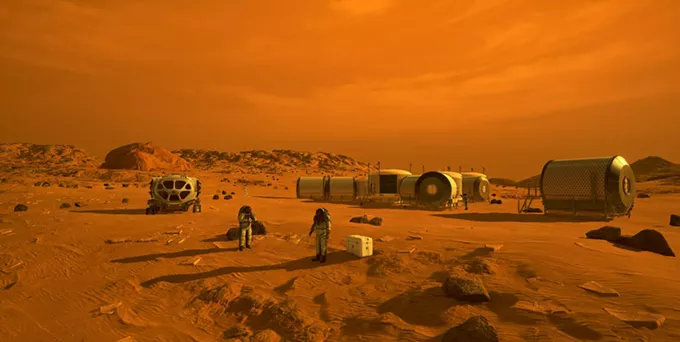
PHOENIX – Is bringing humankind to Mars necessary or realistic in our lifetimes?
Tesla CEO Elon Musk is adamant about it, and he and two fellow billionaires are pushing the boundaries of how far private companies have gone into the stratosphere and beyond.
But some experts are raising concerns about the high-priced and publicity grabbing aeronautics.
“Space is not forgiving. It’s conspiring to kill you every minute,” said Madhu Thangavelu, a lecturer at the University of Southern California and expert in the design of complex space projects, including space stations and exploratory missions. “And we have this innate desire to go out and be among the stars … but we are not capable biologically to do that.”
Despite such daunting obstacles, Thangavelu, who has discussed space travel with Musk, finds the early efforts promising.
In May, SpaceX successfully launched and landed a Starship rocket for the first time without exploding. Starship SN15’s completion of the high-altitude flight test marked a huge milestone in Musk’s ambitions to send humans to Mars.
SpaceX estimates it would take six months to get to Mars. Thangavelu said he has asked Musk many times about the logistics of passengers living in a rocketship for that long. Musk told him that he’ll set people up with where they want to go but it’s their business what they do during the time it takes to get there.



